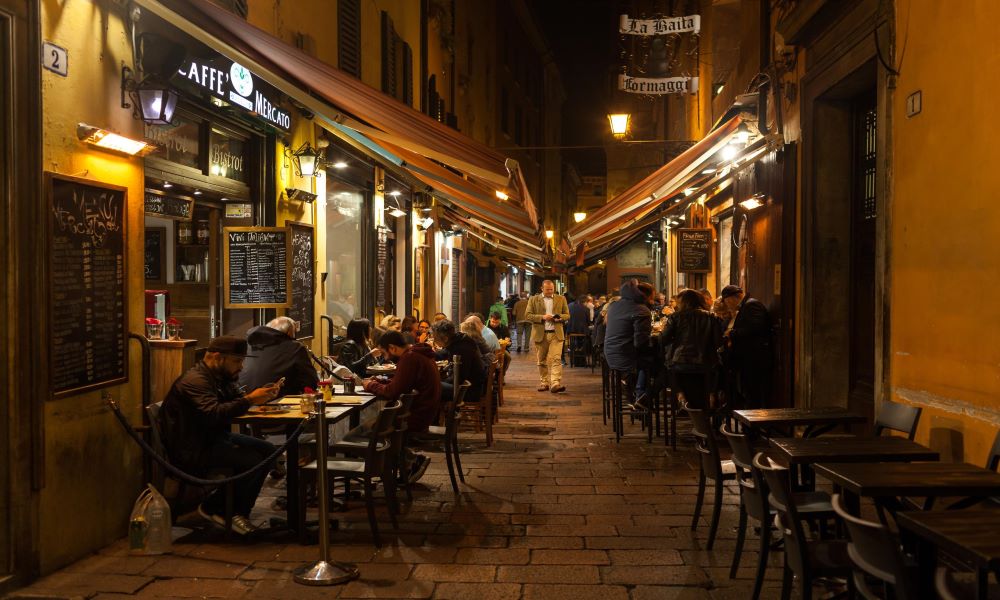A brief history of Bologna's osterie
The origin of Bologna's osterie dates back to the Middle Ages. In particular, their popularity grew from the middle of the 13th century, so much so that only a century later there were as many as 150 in the city. The inns' first name was 'Hospitali', a term that evokes the hospitality that these places offered to pilgrims passing through the city. Initially, they were run by religious congregations, but for a fee they also gave hospitality to merchants.The transition to osterias came during the Renaissance, when they welcomed students, merchants and travellers eager for a hot meal, a glass of wine and sometimes even a bed. Dishes served to guests included pasta and beans, meatballs and friggione (a sauce made from tomatoes and onions). Some 'Hostarie' also offered other (illicit) entertainment to patrons, such as gambling or female companionship.
As the centuries went by, the 'osterie' became the meeting place of Bologna's intellectuals, particularly in the 19th century when they were considered a mirror of the city's cultural and political situation. This was the period when Giosuè Carducci visited the osterie. His regular table was in the Bottiglieria Cillario del Mercato di Mezzo.
Another transformation took place between the 1950s and 1970s, when the osterie became venues for live music. In addition to wine and conviviality, therefore, osterias such as Buca delle Campane, Osteria da Vito and Osteria dei Poeti added music to their menus, thus forever linking their name to that of the singer-songwriters who went there. In other osterias, such as Cantina Bentivoglio and Osteria dell'Orsa, live jazz concerts took place every day.
Today, some of Bologna's oldest osterie have survived until the present day but have often adapted to the demands of today's clientele. You do not expect them to retain the atmosphere of the past, but nevertheless that typical sense of conviviality has not been lost.

Osteria del Sole
One of the most famous and popular osterias in the city centre is the Osteria del Sole, which not by chance is still located in the Mercato di Mezzo area. And it is no coincidence, because in the old days osterias were located precisely in the busiest areas of the city, such as the markets.
Over the centuries, the osteria's fame grew to such an extent that in 1712 it was included in the 'Giuoco nuovo di tutte le osterie che sono in Bologna' by Giuseppe Maria Mitelli, a sort of game of the goose made by the Bolognese engraver. The game includes about sixty osterie in the centre, and each one has a small box containing its name, address, sign and gastronomic specialities.
Currently run by the Spolaore family, the Osteria del Sole in vicolo Ranocchi has been active since 1465. It is best known in the city for its special formula, which allows guests to bring in food from outside and eat it seated at the restaurant's long tables.
Osteria Al Cappello Rosso
Another historic osteria still in operation is the Osteria 'Del cappello', or also Osteria 'Al Cappello Rosso', a few steps from Piazza Maggiore. Dating back to 1375, this ancient place boasts a very curious history: its premises were the only ones in Bologna authorised to offer hospitality to Jews. Its location, close to Piazza Maggiore and outside the city walls, which at the time passed right through the square, in fact guaranteed a certain protection to such travellers, while at the same time subjecting them to greater control by the local authorities. The Osteria Al Cappello Rosso is still active today as a typical Bolognese restaurant.
Osteria da Mario
Finally, let us mention the Osteria da Mario in Via San Felice. The history of this osteria is that of the mother-son couple (Maria known as Marieina and Mario), who ran the restaurant from 1940 until 2008, and that of the illustrious patrons who frequented it in the 1960s, such as Lucio Dalla, Pierpaolo Pasolini and Walter Chiari. Today, the osteria continues its activities under new management.If you would like to discover all the secrets of Bologna's osterie in the company of a guide (and taste their food and wine specialities), you could take part in the bike tour of Bologna's osterie organised by Travelhoo.

